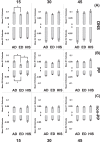Racioethnic Differences in Human Posterior Scleral and Optic Nerve Stump Deformation
- PMID: 28846773
- PMCID: PMC5574446
- DOI: 10.1167/iovs.17-22141
Racioethnic Differences in Human Posterior Scleral and Optic Nerve Stump Deformation
Abstract
Purpose: The purpose of this study was to quantify the biomechanical response of human posterior ocular tissues from donors of various racioethnic groups to better understand how differences in these properties may play a role in the racioethnic health disparities known to exist in glaucoma.
Methods: Sequential digital image correlation (S-DIC) was used to measure the pressure-induced surface deformations of 23 normal human posterior poles from three racioethnic groups: African descent (AD), European descent (ED), and Hispanic ethnicity (HIS). Regional in-plane principal strains were compared across three zones: the optic nerve stump (ONS), the peripapillary (PP) sclera, and non-PP sclera.
Results: The PP scleral tensile strains were found to be lower for ED eyes compared with AD and HIS eyes at 15 mm Hg (P = 0.024 and 0.039, respectively). The mean compressive strains were significantly higher for AD eyes compared with ED eyes at 15 mm Hg (P = 0.018). We also found that the relationship between tensile strain and pressure was significant for those of ED and HIS eyes (P < 0.001 and P = 0.004, respectively), whereas it was not significant for those of AD (P = 0.392).
Conclusions: Our results suggest that, assuming glaucomatous nerve loss is caused by mechanical strains in the vicinity of the optic nerve head, the mechanism of increased glaucoma prevalence may be different in those of AD versus HIS. Our ONS strain analysis also suggested that it may be important to account for ONS geometry and material properties in future scleral biomechanical analysis.
Figures








References
-
- Rudnicka AR, Mt-Isa S, Owen CG, Cook DG, Ashby D. . Variations in primary open-angle glaucoma prevalence by age, gender, and race: a Bayesian meta-analysis. Invest Ophthalmol Vis Sci. 2006; 47: 4254– 4261. - PubMed
-
- Anderson DR, Hendrickson A. . Effect of intraocular pressure on rapid axoplasmic transport in monkey optic nerve. Invest Ophthalmol Vis Sci. 1974; 13: 771– 783. - PubMed
Publication types
MeSH terms
Grants and funding
LinkOut - more resources
Full Text Sources
Other Literature Sources
Medical
Miscellaneous

